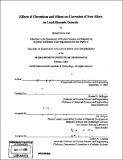| dc.contributor.advisor | Ronald G. Ballinger. | en_US |
| dc.contributor.author | Lim, Jeongyoun | en_US |
| dc.contributor.other | Massachusetts Institute of Technology. Dept. of Nuclear Science and Engineering. | en_US |
| dc.date.accessioned | 2008-04-23T14:41:45Z | |
| dc.date.available | 2008-04-23T14:41:45Z | |
| dc.date.copyright | 2006 | en_US |
| dc.date.issued | 2006 | en_US |
| dc.identifier.uri | http://hdl.handle.net/1721.1/41288 | |
| dc.description | Thesis (Sc. D.)--Massachusetts Institute of Technology, Dept. of Nuclear Science and Engineering, 2006. | en_US |
| dc.description | Includes bibliographical references. | en_US |
| dc.description.abstract | The high power densities and temperatures expected for next generation nuclear applications, including power generation and transmutation systems, will require new types of heat transport systems to be economic. Present interest in heavy liquid metal coolants, especially in lead and lead-bismuth eutectic, originates from such requirements as increased heat removal capacity and enhanced safety features. However, corrosion of structural metals represents a major limiting factor in developing advanced liquid Pb-alloy coolant technology. In fact, the development of advanced structural and cladding alloys that are resistant to corrosion over a wide range of oxygen potentials in this environment would represent the enabling technology for these systems. The goal of this research was to develop a class of Fe-Cr Si alloys that are resistant to corrosion in Pb and Pb alloys at temperatures of 6000C or higher. As a necessary part of this development effort, an additional goal was to further develop the fundamental understandings of the mechanisms by which corrosion protection is achieved. A series of alloys based on the Fe-Cr-Si system were proposed as potential candidates for this application. These alloys were then produced and evaluated. The results of this evaluation verified the hypothesis that an Fe alloys with suitable levels of Cr (>12 wt%) and Si (> 2.5 wt%) will be protected by either a tenacious oxide film (over a wide range of oxygen potentials above the formation potential for Cr and Si oxides) or by a low solubility surface region (at low oxygen potentials) Experimental results obtained from model alloys after lead-bismuth eutectic exposure at 6000C demonstrated the film formation process. | en_US |
| dc.description.abstract | (cont.) The hypothesis that Si addition would promote the formation of a diffusion barrier was confirmed by the actual reduction of oxide thickness over time. The Si effect was magnified by the addition of Cr to the system. Based on a kinetic data assessment on the experimental results of Fe-Si and Fe-Cr-Si alloys, the synergetic alloying effect of Cr and Si was revealed. An improved understanding on the kinetic process and its dependence on the alloying elements has been achieved. | en_US |
| dc.description.statementofresponsibility | by Jeongyoun Lim. | en_US |
| dc.format.extent | 134 leaves | en_US |
| dc.language.iso | eng | en_US |
| dc.publisher | Massachusetts Institute of Technology | en_US |
| dc.rights | M.I.T. theses are protected by
copyright. They may be viewed from this source for any purpose, but
reproduction or distribution in any format is prohibited without written
permission. See provided URL for inquiries about permission. | en_US |
| dc.rights.uri | http://dspace.mit.edu/handle/1721.1/7582 | en_US |
| dc.subject | Nuclear Science and Engineering. | en_US |
| dc.title | Effects of chromium and silicon on corrosion of iron alloys in lead-bismuth eutectic | en_US |
| dc.type | Thesis | en_US |
| dc.description.degree | Sc.D. | en_US |
| dc.contributor.department | Massachusetts Institute of Technology. Department of Nuclear Science and Engineering | |
| dc.identifier.oclc | 213482309 | en_US |
